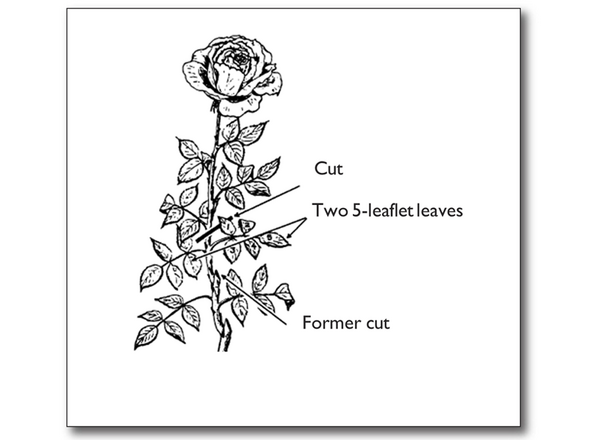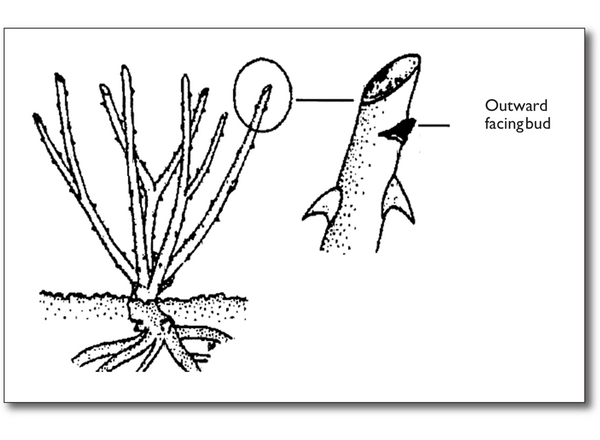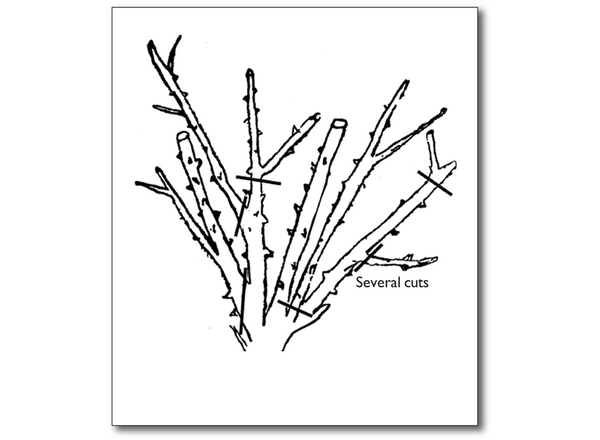
Dead-heading is the removal of faded flowers before they can develop seed. Dead-heading is a form of summer or day-to-day pruning. The standard recommendation is to cut the flower stem back to an outward-facing bud above a five-leaflet or seven-leaflet leaf.
This "rule" applies best to plants that are vigorous. If the plant is weak or small, you may not want to cut off as much material. Each time you remove this much wood you are removing a lot of the food-making ability of the plant. This method works well for most recurrent-blooming types of roses. With rugosa and other shrub roses where hips are a part of the display, you may not want to prune off the old flowers. In this case, simply clean the spent blooms away with your hand, leaving the hips. Flowers should not be cut after October 1 to allow the plant to begin hardening off for the winter. Dead-heading is also a good way to lessen the likelihood of diseases such a botrytis from becoming a problem
The pruning of rose bushes can be confusing, especially when you start talking about hybrid teas, old garden roses, shrub roses, once-blooming roses, and English roses. This confusion leads to doubt and improper pruning or no pruning.
The class of rose and the time of year it blooms influence the type and amount of pruning. General pruning principles apply to all roses, but there are differences between classes. The closer one gets to species roses the less severe the pruning. Hybrid teas have the distinction of requiring the most severe pruning for optimum bloom and plant health.
Because of the variety of rose types available, one may need to have an understanding of how the rose flowers. Pruning should also be looked at as applying a few common sense principles to accomplish several tasks. These tasks are to remove dead, damaged, or diseased wood; increase air circulation; keep the shrub from becoming a tangled mess; shape the plant; and encourage the growth of flowering wood.
The majority of pruning is done in the spring. Many rose growers suggest waiting until the forsythias start to bloom as a good signal for the pruning season to begin.
The goal of spring pruning is to produce an open centered plant. This allows air and light to penetrate easily.

Basic pruning fundamentals that apply to all roses include:
- Use clean, sharp equipment.
- Cut at a 45-degree angle about 1/4 inch above outward-facing bud. The cut should slant away from the bud.
- Entirely remove all dead or dying canes. These can be identified as canes that are shriveled, dark brown, or black.
- If cane borers are a problem, it is suggested to seal the ends of the cuts to prevent the entry of cane borers. White glue works well.
- Remove all thin, weak canes that are smaller than a pencil in diameter.
- If roses are grafted and there is sucker growth, remove it. The best way is to dig down to the root where the sucker is originating and tear it off where it emerges. Cutting suckers off only encourages regrowth of several suckers where there once was one.

Roses like hybrid teas, grandifloras, floribundas, and miniatures produce the best flowers on new or current season's wood. To ensure this type of wood, these roses are pruned very hard in early spring. This usually means removing about one-half to two-thirds of the plant's height and reducing the number of canes.
Suggested pruning sequence:
- Remove all dead canes; cut them off at the base or point of discoloration.
- Remove small, weak canes.
- Leave 3 to 5 healthy, stout canes evenly spaced around the plant.
- Cut these canes back, leaving 3 to 5 outward-facing buds.
Repeat-flowering shrub roses bear flowers on mature stems that are not old and woody. Severe pruning of these roses would result in reduced flower production. In their first two or three seasons in the garden, shrub roses can be left unpruned. Wait to see what shape develops and then try to prune so that the shape is maintained. Many modern shrub roses are pruned by a method called the "one-third" method. Suggested pruning sequence:
- In the spring, remove one-third of the very oldest canes. This helps keep the plant from becoming an overgrown thicket of poor-flowering canes.
- Replace these canes by identifying about one-third of the very youngest canes that grew the previous season.
- Remove the remaining canes.
The result of this one-third method is that you are continually renewing the rose while at the same time keeping enough mature wood to ensure a good supply of flower-producing wood.
These roses are pruned much like modern shrub roses with some important considerations based on class. Old once-blooming roses such as Alba, Gallica, Centifolia, Damasks, and Mosses produce flowers on old wood, all pruning should be delayed until after flowering. Then, you do as little or as much pruning as is required to maintain the plant. Thinning and removing old wood is encouraged. These roses may not need annual pruning if there is no dead or damaged wood present.
Repeat-flowering old garden roses such as Bourbons, Hybrid Perpetuals, and Portlands bloom on both new and old wood. These can be pruned before they flower and pruned harder without fear of losing blooms.
Climbers and ramblers may need a few seasons in the garden before pruning is necessary. In many cases, pruning is limited to removing winter-damaged wood. Pruning is similar for both classes. The difference is in the timing. Because ramblers are once-blooming, they are pruned right after flowering in early summer. Because climbers are repeat bloomers, they are pruned in early spring. Reducing the side shoots or laterals to 3-6 inches stimulates flower production, resulting in more blooms. Training canes to grow more horizontally encourages the growth of bloom producing side shoots.